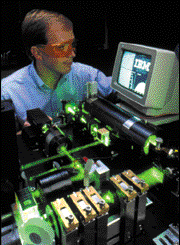
Holography Offers New Opportunities
Hank Hogan
A picture may be worth a thousand words, but a hologram is worth many more.
Independent projects at IBM's Almaden Research Center and NASA's Jet Propulsion Laboratory in Pasadena, Calif., have demonstrated the use of holographic associative information retrieval to solve problems in data retrieval and image recognition, respectively.

Geoff Burr of IBM's Almaden Research Center in San Jose, Calif., tests a holographic technique that can retrieve lost data without knowledge of its location in the storage medium.
At Almaden, the researchers used holograms to locate and retrieve information without knowing its address in a storage medium, but by knowing some of its content. A photosensitive medium captured the interference fringes that arise when a data-encoded laser beam intersects a reference beam. In the setup, shining a reference beam through the medium at the same angle would re-create the data beam for readout, but if the angle were unknown, the data would be difficult to retrieve.
The IBM researchers solved this problem by reversing the retrieval process. They sent a beam encoded with part of the data through the medium. All the reference beams used in the storage process burst forth. The brightest beam was the reference beam that most closely matched the partial data. They then sent a beam at that angle to re-create the entire original data beam.
At the Jet Propulsion Laboratory, gray-scale optical correlators have been applied to an automatic target-recognition system. The correlators spot a target by converting a gray-scale frame of an object into a data beam, which then is compared with all the images stored in holographic memory at once. The technique, which operates on the same principle as the IBM retrieval process, offers high storage density, random access and high data-transfer rates.
Today, the camcorder-size, automatic target-recognition system operates at 128 × 128-pixel resolution and 1000 fps. Work is under way on a matchbox-size device with 512 × 512-pixel resolution. Although originally developed for target acquisition, these devices may be suitable for face recognition, fingerprint identification, traffic and security monitoring, or robotic vision, noted Tien-Hsin Chao, technical group leader of the laboratory's advanced computing technologies group.
Published: September 2000